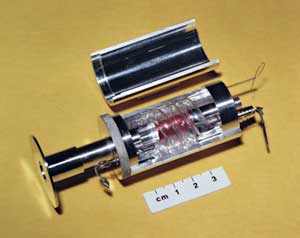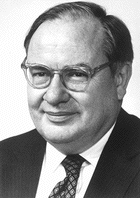The principle of the laser was recognized in 1917, when physicist Albert Einstein described the theory of “stimulated emission.” However, it was not until the late 1940s that engineers began to use this principle for practical purposes. At that time, physicists like Charles Townes were looking for ways to improve a class of radar-related vacuum tubes. Townes proposed constructing a powerful new amplifier by passing a beam of electromagnetic waves through a special cavity containing molecules of a gas. The beam stimulated the atoms in the gas to release their energy exactly in step (or as engineers say, in phase) with the waves of the beam. That energy then exited the cavity as a much more powerful beam. Thus, a small amount of energy supplied to the cavity resulted in a huge power output, and therefore the device was a new kind of amplifier.
Townes called his device the MASER, which stood for Microwave Amplification by the Stimulated Emission of Radiation. Within a short time, the MASER was in use as an amplifier in microwave communication systems. But Townes and other engineers also believed that by using higher-frequency energy, they could create an optical maser, a device for generating powerful beams of light (light consists of electromagnetic waves of a higher frequency than microwaves). Gordon Gould, Townes and his colleague Arthur Schawlow, and two physicists from the Soviet Union all proposed such a device, but it remained for Theodore Maiman, who used a ruby rod, to construct the first LASER (Light Amplification by the Stimulated Emission of Radiation).
The LASER was a remarkable technical breakthrough, but in its early years it was not powerful enough for use in the beam weapons envisioned by the military, and its usefulness for transmitting information through the atmosphere was severely hampered by its inability to penetrate clouds and rain. Soon, though, some began to find uses for it. Maiman and his colleagues developed some of the first LASER weapon sighting systems, and other engineers developed powerful lasers for use in surgery and other areas where a moderately powerful, pinpoint source of heat was needed. Today, for example, LASERS are used in corrective eye surgery, providing a precise source of heat for cutting and cauterizing tissue.
Following the invention of the ruby laser, many other materials were found that could be used as the basis of laser action, such as sapphire, neodymium, and organic dyes such as rhodamine 6G. The first gas discharge laser was created in 1962 using a Helium-Neon mixture. There were also different ways to excite various compounds to the point of lasing, such as certain chemical reactions, or the acceleration of free electrons to very high energy levels. Research on lasers made from semiconductor compounds was especially active, since by this time it was known that some semiconductors were capable of emitting light (as in the Light Emitting Diode, or LED). In specially prepared devices, simply passing electricity through the device causes laser action. Robert N. Hall invented the first semiconductor-injunction laser that was based on this principle in 1962. Semiconductor lasers are simple, efficient, and inexpensive, and are widely used for optical communication, CD players, laser printers, and other technologies.

